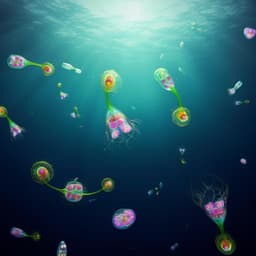
Earth Sciences
Anomalous trends in global ocean carbon concentrations following the 2022 eruptions of Hunga Tonga-Hunga Ha'apai
B. A. Franz, I. Cetinić, et al.
This groundbreaking study by Bryan A. Franz, Ivona Cetinić, Amir Ibrahim, and Andrew M. Sayer reveals anomalies in ocean biogeochemical properties following the 2022 Hunga Tonga-Hunga Ha'apai eruptions, spotlighting a significant decline in phytoplankton carbon concentrations detected via satellite but not in situ. The findings underscore the impact of aerosols on ocean color retrieval algorithms, emphasizing potential future threats to ocean ecosystem monitoring.
~3 min • Beginner • English
Introduction
The study investigates anomalous trends in satellite-derived ocean color products in 2022, particularly declines in phytoplankton carbon (Cphy) inferred from particulate backscattering (bbp(443)), following the Hunga Tonga-Hunga Ha'apai eruptions. Prior analyses of MODIS Aqua indicated unusual behavior outside the 25-year climatology, driven by deviations in the equatorial and southern hemispheres and potentially linked to volcanic activity near Tonga. The eruptions injected unprecedented water vapor and sulfur dioxide into the stratosphere, producing sulfate aerosol layers with elevated loading through 2022. The core research question is whether observed satellite ocean color anomalies reflect true biological responses (e.g., from volcanic ash nutrient inputs) or are artifacts due to atmospheric correction errors under abnormal stratospheric aerosol conditions. Resolving this is important because ocean color data underpin assessments of global phytoplankton dynamics and climate impacts, and misinterpretation could distort understanding of ocean ecosystems and biogeochemical cycles.
Literature Review
Background literature documents the atmospheric and radiative impacts of the Hunga Tonga eruptions, including plume heights up to ~50–55 km, oxidation of SO2 to sulfate aerosols forming layers at ~24–26 km, and persistent stratospheric aerosol and water vapor anomalies through 2022. Foundational work on atmospheric correction for ocean color highlights assumptions of tropospheric aerosol location and weak aerosol absorption. Prior studies show volcanic ash can stimulate phytoplankton via nutrient (iron) deposition, leading to biological responses. The study builds on these domains by examining whether the 2022 anomalies reflect biological change or retrieval artifacts caused by stratospheric aerosol-ozone interactions not accounted for in standard algorithms.
Methodology
The analysis integrates multiple data streams and simulations. Satellite ocean color data: Six active missions were used from NASA OB.DAAC, representing MODIS (Aqua, Terra), VIIRS (SNPP, NOAA-20/JPSS-1), and OLCI (Sentinel-3A, Sentinel-3B). NASA multi-mission data (R2022.0) used a common atmospheric correction (AC). Products included Rrs(λ), chlorophyll-a (Chla), and bbp(443), with bbp(443) linearly related to phytoplankton carbon. Level-3 monthly binned products (4.6 × 4.6 km on a sinusoidal grid) were spatially averaged to produce regional time series for 0–50° N (NH), 0–50° S (SH), and the South Pacific Subtropical Gyre (SPSG). To test dependence on NASA AC, OLCI time series processed independently by EUMETSAT were also analyzed. Cross-mission comparisons used standardized anomalies relative to each sensor’s pre-2022 monthly mean and standard deviation. Atmospheric aerosol data: NASA OMPS limb profiler provided monthly multi-wavelength stratospheric aerosol optical thickness (AOT) on a 5° × 15° grid from March 2012 onward. AOT at 675 nm was used; area-weighted monthly geometric means were computed for regions. In situ ocean optics: BGC-Argo bbp(700) profiles within the SPSG (2016–2022) were processed (de-spiking with moving median, alignment using 700–750 m means, surface selection 5–20 m, 7-day grouping, 5th–95th percentile filtering), yielding 58,901 data points from 33 floats. Radiative transfer simulations: A fully coupled vector radiative transfer model simulated satellite-observed total reflectance under two scenarios: (1) only tropospheric aerosols and (2) added stratospheric sulfate aerosol layer. Common settings: wind 5 m s−1, clear water Chla = 0.3 mg m−3, water vapor 1.25 cm, ozone 320 DU (US Standard Atmosphere 1976). Aerosol vertical distributions were Gaussian with 2 km standard deviation; tropospheric layer centered at 2 km with AOT 0.08 (869 nm), stratospheric sulfate layer centered at 23 km with monthly AOT at 869 nm derived from OMPS over the SPSG. Viewing geometry approximated MODIS Aqua (view zenith 25°, relative azimuth 80°) with monthly solar geometry variation. Tropospheric aerosols followed Ahmad et al. (bimodal, coarse-mode dominant, fine fraction 0.01, RH 70%); stratospheric aerosols followed Taha et al. (refractive index 1.45 + 0i, median radius 0.2 μm, width 1.6). Simulated radiances were processed with NASA’s standard AC (L2gen) to retrieve Rrs(λ) and derive bbp(443). Sensitivity analyses compared time series ratios: observed 2022 monthly means vs 2003–2021 means; simulated with-stratospheric-aerosol retrievals vs without-aerosol retrievals. Ozone and gas transmittance effects within MODIS bands were assessed to understand spectral sensitivity (noting strongest ozone absorption impacts between 500–700 nm).
Key Findings
- Cross-sensor satellite anomalies: In 2022, southern hemisphere Rrs and bbp(443) exhibited strong negative deviations relative to the 2002–2021 climatology, especially at green wavelengths (e.g., 547–560 nm). Deviations typically reached about 3 standard deviations below long-term means across MODIS (Aqua, Terra), VIIRS (SNPP, JPSS-1), and OLCI (NASA and EUMETSAT processing), indicating sensor-independent behavior. Northern hemisphere trends largely followed climatology.
- Chlorophyll-a behaved differently: Chla seasonal cycles were near climatology in the SH and slightly elevated in the NH during 2022 (consistent with La Niña), contrasting with the depressed bbp(443) and Rrs, implying a product-specific effect.
- Stratospheric aerosol anomaly: OMPS showed stratospheric 675 nm AOT increases peaking in June–July 2022 at 6–7 times historical averages in equatorial to SH regions, temporally aligned with the negative Rrs anomalies.
- In situ validation: BGC-Argo bbp(700) in the SPSG showed no change in 2022 relative to 2016–2021, contradicting the satellite-indicated decline in particle backscatter/phytoplankton carbon.
- Mechanism via AC bias: Radiative transfer simulations demonstrated that when stratospheric aerosols are mixed with ozone, applying a standard AC that assumes aerosols lie below the ozone layer causes underestimation of ozone absorption, particularly in the green-red spectral range. After AC, this leads to underestimation of water-leaving radiance/reflectance with a spectral bias following ozone absorption features. The simulated ratios of 2022-like vs baseline conditions reproduced the observed decreases in Rrs(443), Rrs(547), and bbp(443), supporting a retrieval artifact rather than a true biological signal.
- Differential product sensitivity: Due to algorithmic design, bbp(443) (from spectral optimization of a bio-optical model) is more sensitive to absolute magnitude and spectral-shape biases in Rrs than open-ocean Chla algorithms (based on spectral band ratios/differences), explaining the stronger impact on bbp-derived phytoplankton carbon.
Discussion
The findings support the hypothesis that the 2022 anomalies in southern hemisphere ocean color products arose from atmospheric correction errors linked to stratospheric aerosol loading after the Tonga eruptions, not from a basin-scale decline in phytoplankton biomass. Cross-sensor agreement and independence from NASA-specific processing (via EUMETSAT OLCI) argue against instrument calibration drift. The absence of anomalies in in situ bbp(700) confirms a lack of real change in particle backscatter/biomass. Simulations replicate the anomaly patterns when aerosol-ozone co-location violates a key AC assumption about aerosol altitude, causing misestimation of ozone absorption and a spectrally structured underestimate of Rrs that propagates strongly into bbp(443) and hence phytoplankton carbon. The work highlights that abnormal stratospheric aerosol burdens can confound satellite assessments of marine ecosystems and that product impacts vary by algorithm sensitivities. It also implies similar risks for other satellite-derived marine variables under altered stratospheric aerosol conditions.
Conclusion
Anomalously high stratospheric aerosol loading following the January 2022 Hunga Tonga-Hunga Ha'apai eruptions induced systematic biases in satellite ocean color retrievals, producing regionally and temporally covarying out-of-family behavior across multiple sensors in 2022. In situ measurements did not corroborate the apparent decline in phytoplankton biomass, and radiative transfer simulations confirmed that aerosol-ozone mixing invalidates a core atmospheric correction assumption, leading to underestimation of Rrs and derived bbp(443). Users should exercise caution interpreting ocean color products during periods of elevated stratospheric aerosols. A prospective mitigation path involves building correction models or look-up tables parameterized by stratospheric aerosol properties and applying ancillary data (e.g., OMPS) prior to standard AC. Future research should focus on algorithm improvements that account for stratospheric aerosol altitude and microphysical variability, validation of corrections across sensors and regions, and evaluation of potential impacts on other satellite products, especially in contexts of natural eruptions and prospective stratospheric geoengineering.
Limitations
The study does not implement a full correction for stratospheric aerosol effects; developing and validating such a correction is deferred and depends on ancillary information about stratospheric AOT and aerosol microphysical properties (size distribution, refractive index) with adequate spatiotemporal resolution. Simulations assume specific aerosol models, altitudes, optical properties, and geometry reflective of SPSG/MODIS conditions, which may not capture all regional or temporal variability. Chlorophyll algorithms are less sensitive but not immune to biases; impacts may differ in optically complex waters. The approach relies on available satellite and float coverage, which may have sampling limitations. Broader generalization to all marine products and sensors requires further testing.
Related Publications
Explore these studies to deepen your understanding of the subject.







